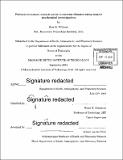Paleoenvironment reconstruction in extreme climates using organic geochemical investigations
Author(s)
Williams, Ross H. (Ross Hamilton)
DownloadFull printable version (11.20Mb)
Other Contributors
Massachusetts Institute of Technology. Department of Earth, Atmospheric, and Planetary Sciences.
Advisor
Roger E. Summons.
Terms of use
Metadata
Show full item recordAbstract
Organic geochemistry provides researchers with an extensive suite of tools for reconstructing past environments. Using these tools, a set of unique locations situated in climatic extremes have been investigated. During the Early Cenozoic the planet was much warmer than today. In addition to this higher background temperature a series of rapid warming events occurred termed hyperthermals. The largest of these, the Paleocene-Eocene Thermal Maximum is perhaps the best analog to modern day anthropogenic climate change. It is paramount to understand the global effects of this event to elucidate potential changes in our near future. To further this area of research two very different regions were chosen to seek out potential deposits that record the hyperthermals. First, in the Cambay Basin of Western India an extensive core was taken during exploration for lignite deposits. This site would have been near the equator during the time of deposition, a region that is important yet not well established in the current literature pertaining to the hyperthermals. Biostratigraphy and palynology combined with bulk organic carbon isotope records reveals that the lowermost portion of the core likely contains the hyperthermal events. Compound-specific isotopic investigation across multiple realms reveals potential variability of carbon in the ocean-atmosphere system that was then complemented by examination of the corresponding kerogens through application of pyrolysis gas chromatography-mass spectrometry. Expanding upon this study the Canadian High Arctic was assessed in the form of paleosols from Banks Island and shales from Strathcona Fiord. Biomarker distributions revealed a shift in environmental conditions from marine to coastal environments from the Paleocene into the Eocene. Hydrogen isotopic investigation reveals that the nalkanes from paleosols can preserve the same signals as rocks from the same time and that the paleohydrology was far different from present day. Finally, a study was conducted of the recent history of Lagunas Miscanti and Miñiques due to their location at high elevations in the dry Chilean Altiplano. Examination of biomarker distribution as well as associated proxies shows that the lakes have undergone significant changes on centennial time scales along with varying biotic communities, water chemistry and lake level.
Description
Thesis: Ph. D., Massachusetts Institute of Technology, Department of Earth, Atmospheric, and Planetary Sciences, 2016. Cataloged from PDF version of thesis. Includes bibliographical references.
Date issued
2016Department
Massachusetts Institute of Technology. Department of Earth, Atmospheric, and Planetary SciencesPublisher
Massachusetts Institute of Technology
Keywords
Earth, Atmospheric, and Planetary Sciences.